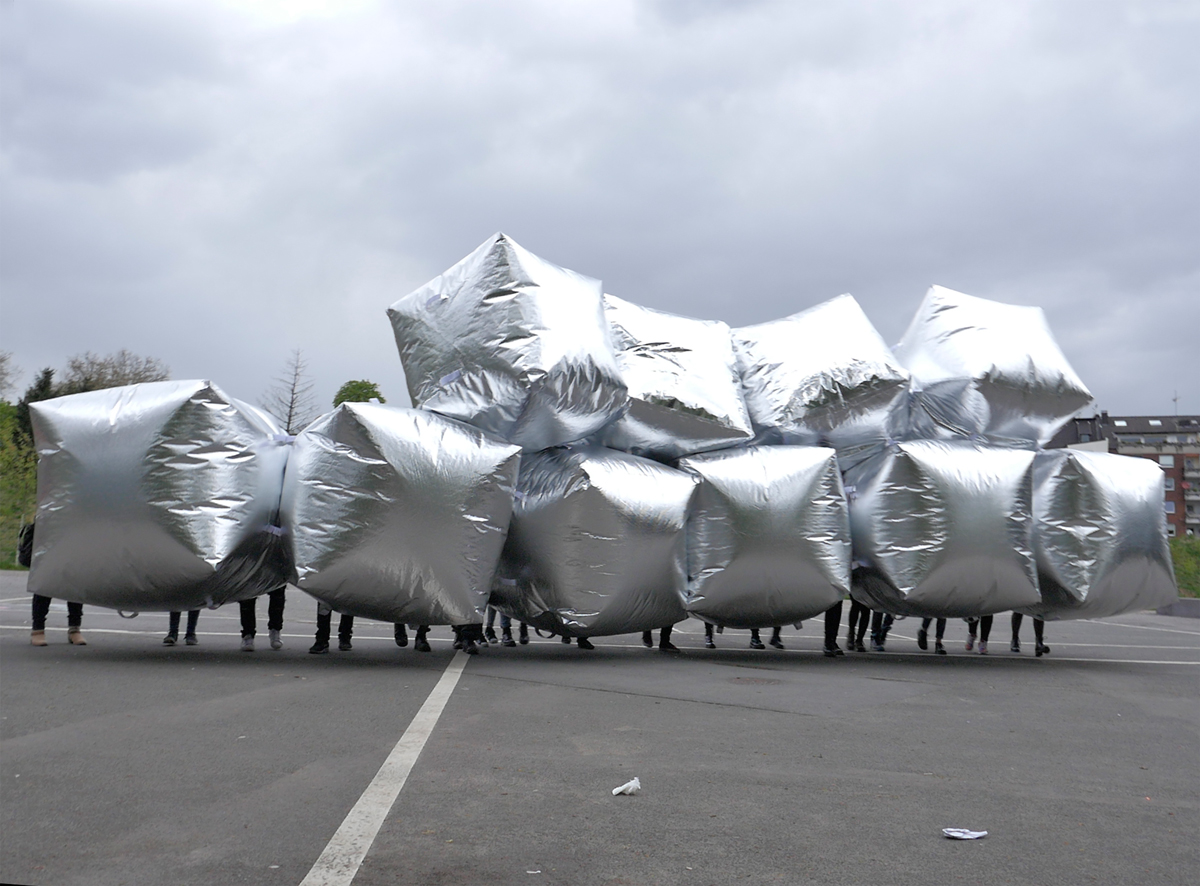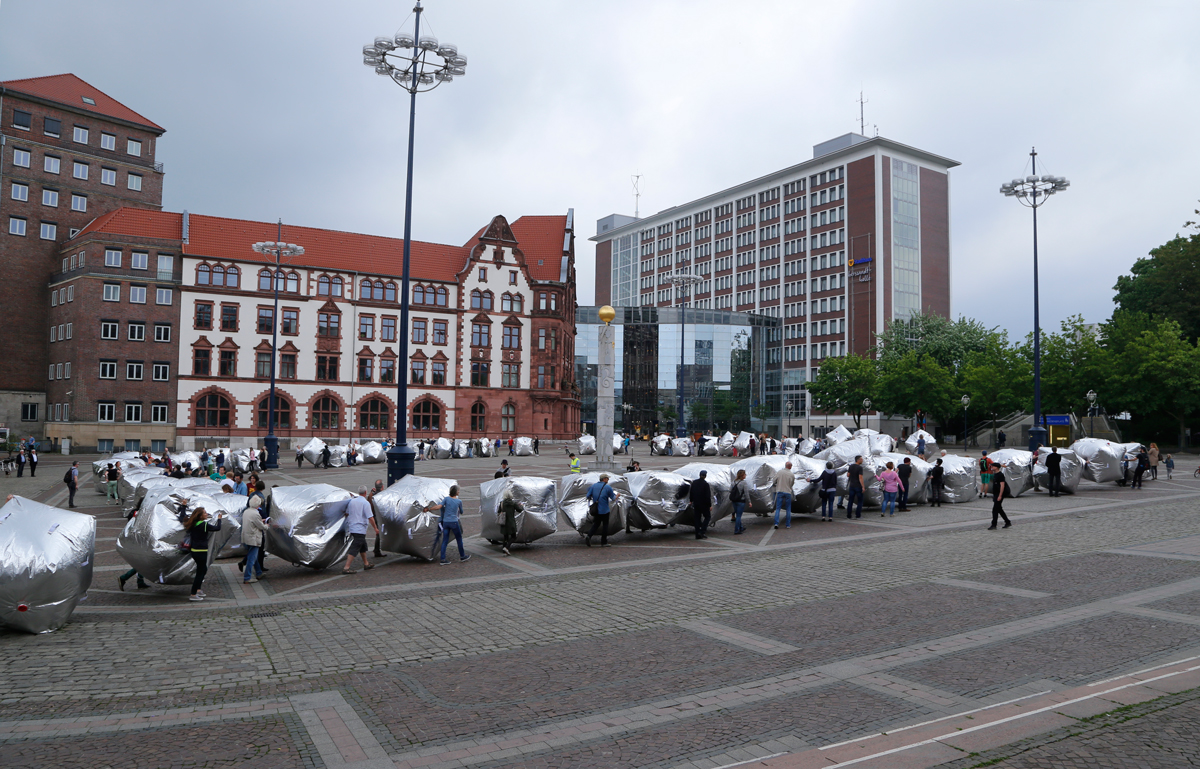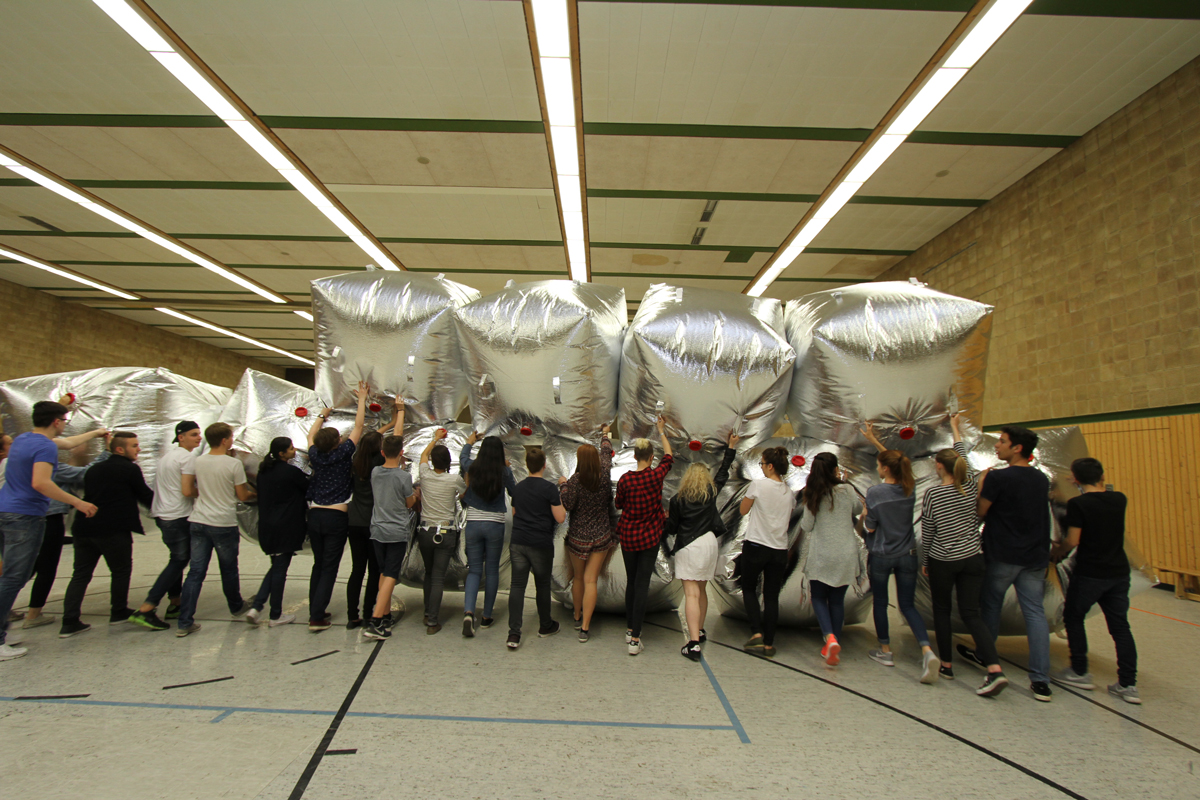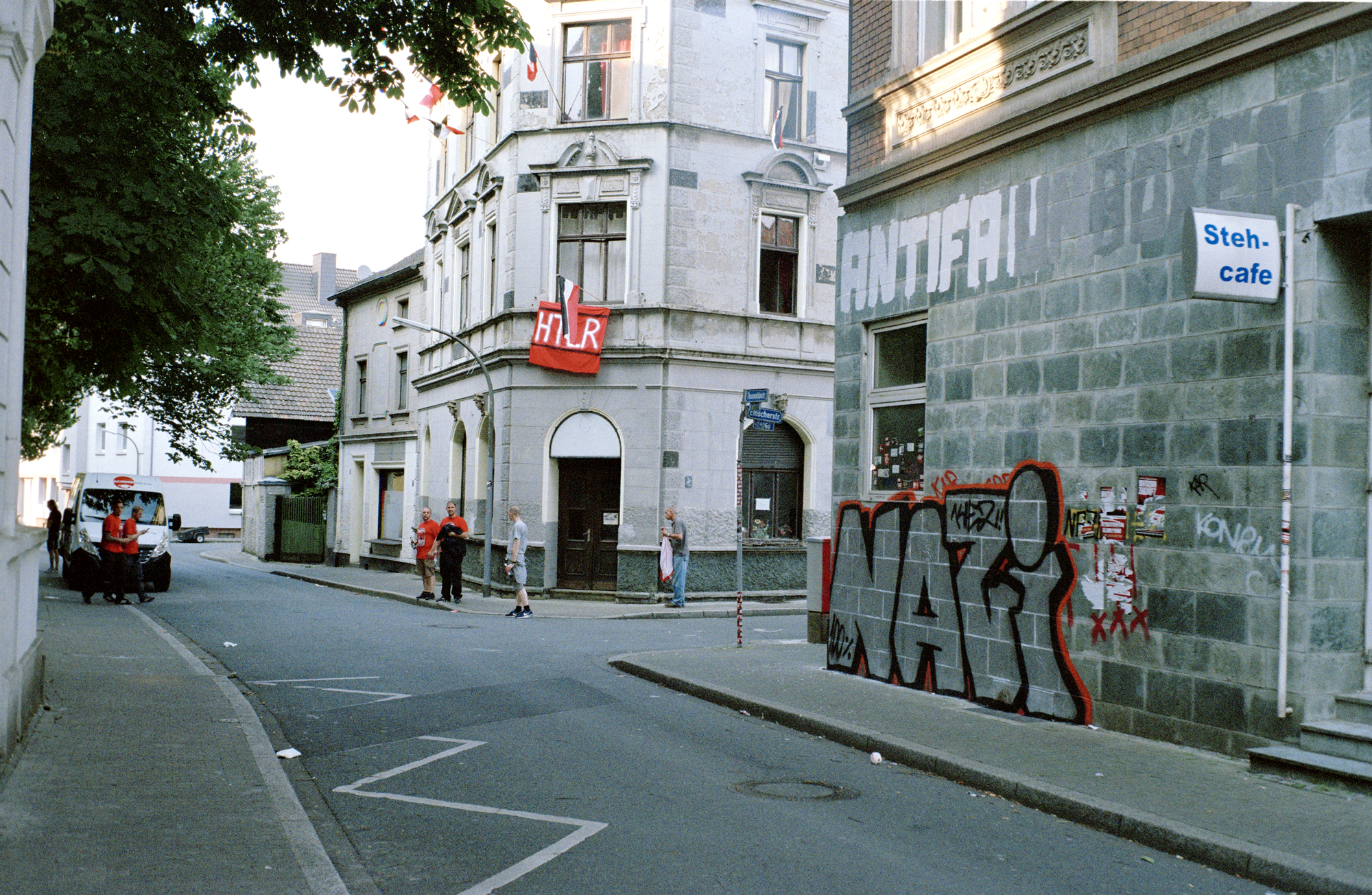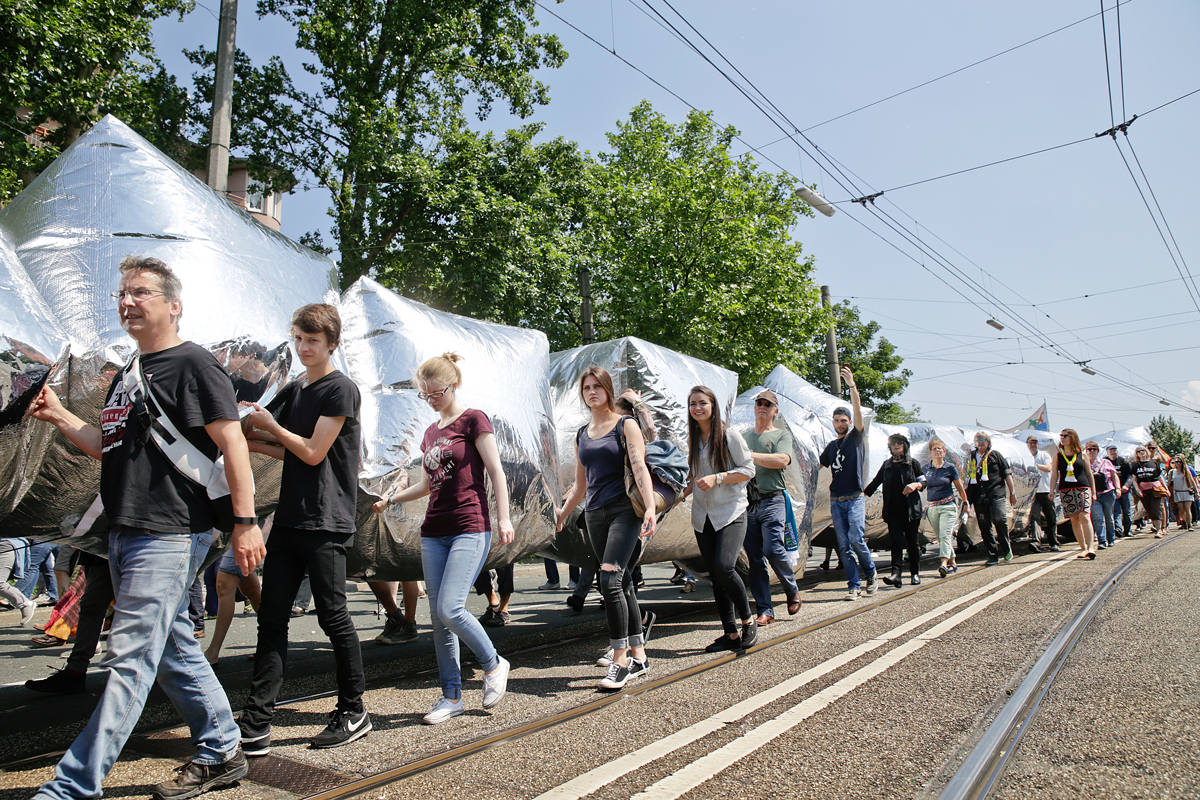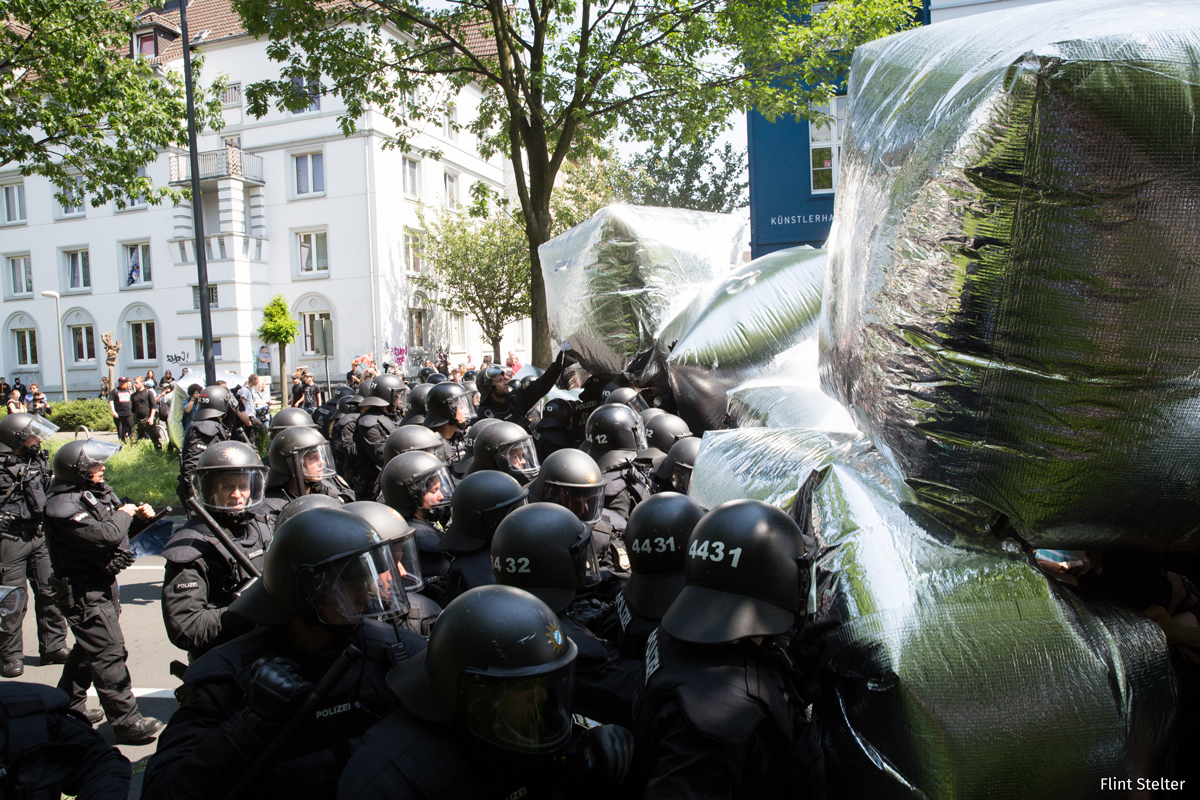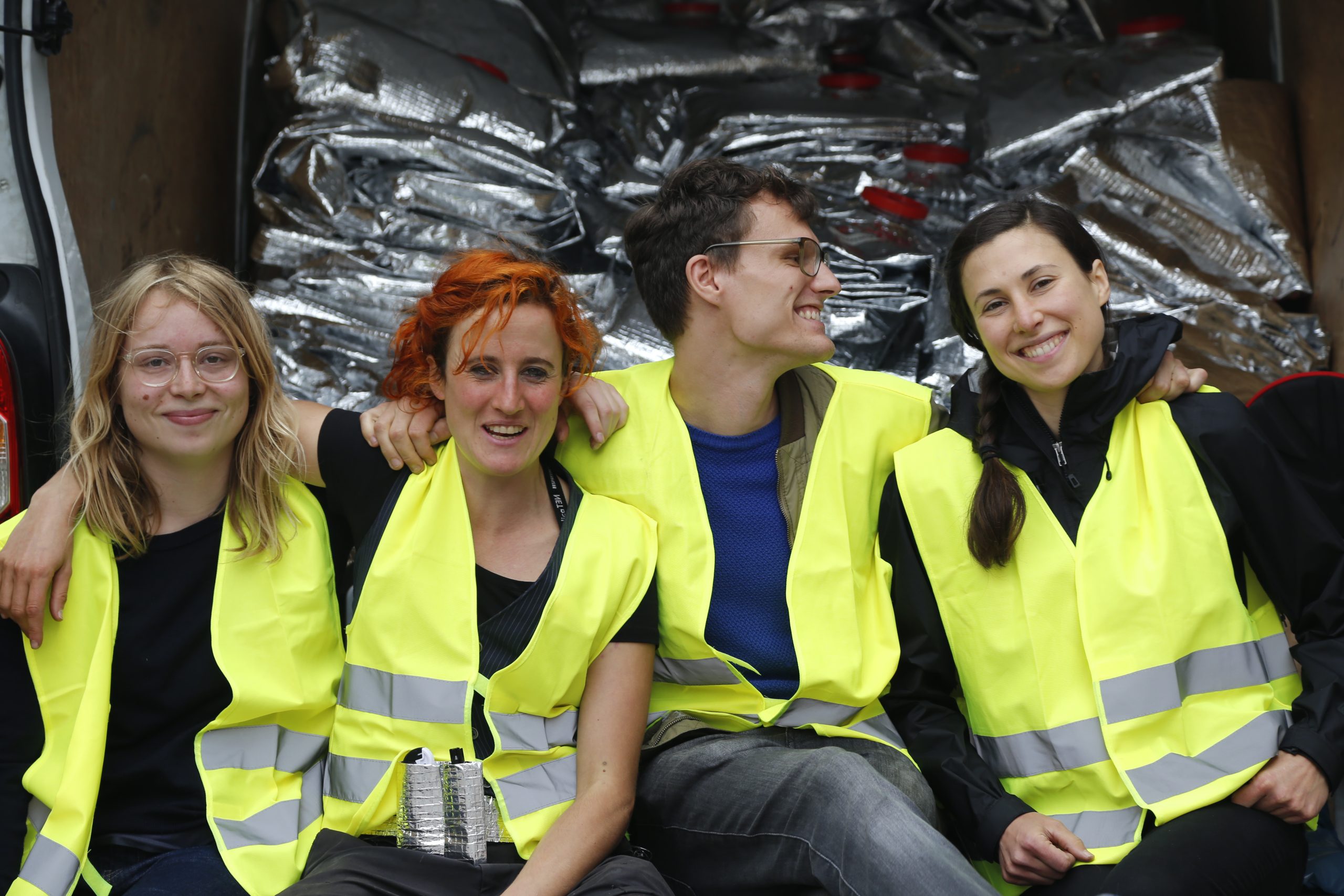The Mirror Barricade (die Spiegel Barrikade) is a social sculpture from modular inflatable mirrored cubes, that can be assembled within seconds into a barricade. It is built by citizens of Dortmund, who positioned themselves against an international right-extremist manifestation in their city.
Dortmund is a post-industrial city in the Ruhr area. The city is plagued by a notorious Neo-Nazi problem. The right-extremist scene consists of eighty violent hardcore members and a larger circle of supporters, that spread fear in the city by bullying, intimidating and even several killings. In 2016, the Neo-Nazis called out for an international demonstration ´Day of German Future – against Alienation.`(Tag der Deutschen Zukunft.) The protest galvanised a strong response of civil society consisting of churches, the unions, the city council and anti-fascist anarchist groups. In collaboration with the Theatre of Dortmund, Tools for Action proposed the Mirrror Barricade, a poetic social sculpture and new protest tactic that built a strategic alliance between the various social actors. The mirror barricade entailed various symbolisms and functionalities: the mirrored side was used to reflect back the hatred and the violence, while also reflect on your own position; the barricade was used to occupy space and collectively position yourself against the right extremist marchers. As the right-extremist scene recruits young members from high schools, it was important for us to work in education. In the course of the project we worked with 14 local schools that were part of the network Schools without Racism — Schools with Courage. Every cube was fabricated by citizens of Dortmund during public workshops. A collective Barricade Ballet with 250 participants, teached collective movement and coordination one week before the action.
Context
The Dortmund Neo-Nazi scene established itself via football hooliganism at the football club Borussia Dortmund since the 1980s. They are held responsible for several murders. A notable case was the Neo-Nazi Michael Berger who at a traffic control shot three police agents and then himself in 2000. In 2016 the Turkish shop owner Mehmet Kubaşık by the terrorist trio National Socialist Underground was killed. It is presumed that the killing was a symbolic ´call to arms`. (See the documentary graphic novel Weisse Wölfe by David Schraven and Jan Feindt.) A street in Dortmund-Dorstfeld is proclaimed to be their ´National Liberated Zone´.
School workshops
During daylong skillshare workshops, students worked together in teams to construct inflatable cubes and also took part in discussions about the neo nazi ideology, to share experiences with the scene, daily forms of racism and how art activism can be empowering.
The whole day was designed to encourage team building. From the very beginning when a truck of supplies from the theatre would arrive, all of the students, teachers and artists from Tools for Action would unload the truck together. We would begin by setting up six custom tables in the school gymnasium or the aula assembly hall, transforming it into a convivial factory for building barricades . The goal was to create a supportive, open and fun environment where students could feel safe to talk about issues of racism and discrimination. By building the cubes together, students built friendships for supporting each other to be courageous and take action to stand up for diversity and inclusion.
After the discussion and presentation about inflatables by Tools for Action, the fabrication workshop began. The entire class would gather together to watch a step by step of demonstration of how to measure and cut the pattern for the inflatable cube. Then the students would form into teams, each locating themselves at one table and using custom-crafted tools to make their cube pattern. The rest of the day would be an ebb and flow of the group coming together to watch a demonstration for the next step, then returning to their team’s table to work together on that step.
As the silver forms would fill with air, so too would the hall fill with excitement and laughter. Students would bounce the inflatables high into the air in celebration and then assemble all the cubes together to learn a series of choreographies and collective movement exercises.
In the course of 5 weeks, hundred and ten cubes were built, creating a wall of eighty meters long and three meters high. One week before the counter protests a ´Barricade Ballet` was staged, in which more than 250 citizens engaged in a playful choreography. The choreography doubled as a collective action training in ways these playful tools could be used to intervene in the neo-Nazi march. “Double spaghetti”, “Pumpkin” “Asterix and Obelix” where among the favorite code words for intervening with these inflatable sculptures as an artistic form of direct action.
Collective Action as Embodied Political Education
On the day of protest, groups could pick up barricade pack, consisting of six cubes, a blower and a battery. They could then decide for themselves how and where they would deploy the cubes. For us, Tools for Action this was a form of embodied political pedagogy, as people´s physical position in public space, would also reflect on their political positioning. Afterwards they could then discuss their experiences.
The inflatable barricades were located at a few gathering points in the city: a playful, family-friendly demonstration at Wilhelmsplatz (the square in Dorstfeld, close to the street the Neo-Nazis call their “national liberated zone”), a blockade located at the end of the march and the barricade at BlockaDO, the more radical demonstration that promoted civil disobedience for blockading the Neo-Nazi march. At the end 900 international Neo Nazi´s showed up, 4300 police men were creating a cordon around their march and 3500 people engaged in counterprotests. The BlockaDO demonstration was kettled in immediately by police. The cubes became cushions and a protection barrier between impassioned protesters and police forces. The police response was to cut the inflatable works into pieces. Seeing the police response, the question arises which values are defended in German society.
Politically the intervention with the Mirror Barricade did not stop the Neo-Nazi March. However, the intervention was succesfull in building a large alliance in a politically divided city; practiced experimental forms of radical pedagogy; sensitised for direct action and above all, it occupied the imagination. By giving attention to the creativity, courage and resistance of civil society, the mirror barricade overshadowed the hate speech and the spreading of fear and violence by the right-extremist marchers.
—
In 2017, Tools for Action together with the Theatre of Dortmund received the Prize for Arts Education from the German Ministry for Arts And Education.
Credits
Tools for Action & Theatre of Dortmund
Tools for Action Team:
Bambi van Balen, Tilly Gifford, Katherine Ball, Camille Martenot
Theatre of Dortmund Team:
Dramaturgy: Alexander Kerlin, Michael Eickhoff
Anne-Kathrin Schulz, Dirk Baumann
Theatre director: Kay Voges
Organization of school workshops:
Sarah Jasinszczak,
Helena Breidt / Municipal Integration Centre of Dortmund
Schools without Racism – Schools with Courage in Dortmund:
Gesamtschule Scharnhorst, Albert-Einstein-Realschule,
Martin-Luther-King-Gesamtschule, Phönix-Gymnasium,
Marie-Reinders-Realschule, Bert-Brecht-Gymnasium,
Droste-Hülshoff-Realschule, Westfalen-Kolleg,
Robert-Schuman Berufskolleg, Robert-Bosch Berufskolleg,
Reinoldi Sekundarschule, Jeanette-Wolff-Schule,
Käthe-Kollwitz Gymnasium, Helene-Lange Gymnasium
Partners:
Arbeitskreis gegen Rechtsextremismus
BlockaDO
no-TddZ

